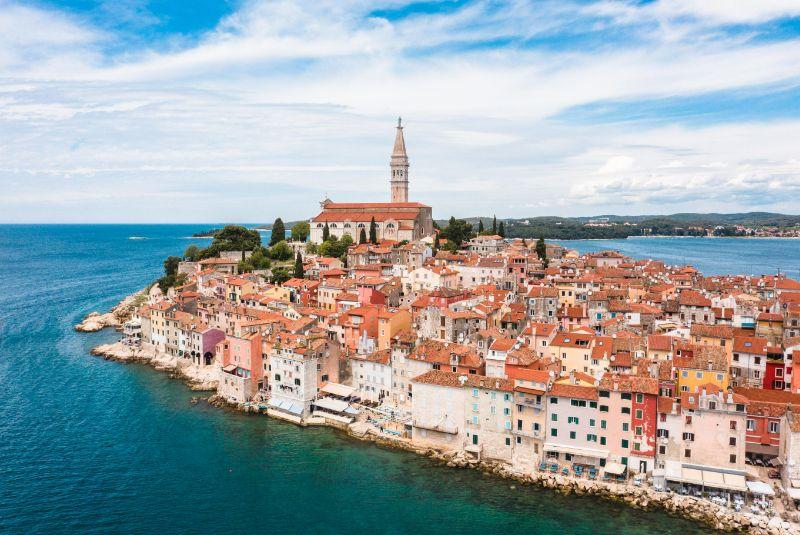
Istria and Kvarner – two beautiful regions on Croatia’s northwesterly peninsula – might not be the first destinations on travellers’ lips when booking trips to the country, but they are ripe for culinary discovery. Join 50 Best on a tour of the coastline, where we find the world’s largest truffles, olive oil steeped in history and outrageously fresh seafood, best served on the terrace of a taverna, with a glass of local icy white wine in hand
Snapshots of cats lazing on shaded steps of well-trodden and sun-dappled medieval streets is ubiquitous across Croatia. With its soft sand beaches, Mediterranean climate, rich history and a coastline showcasing more shades of blue than a Pantone colour chart, it’s easy to see the appeal to those seeking a sun-kissed getaway – as well as a moment of much-deserved respite. But for those who journey deeper into the country’s lesser-known regions and lush, fertile pasture, it’s a culinary treasure trove with a food scene that piques interest, sates the appetite and charms the palate… which does rather beg the question as to whether the country’s many languid felines are really just enjoying a postprandial nap? To travel the regions of Istria and Kvarner is to embark on a modern-day culinary odyssey.
The heart of the matter
Basking in the warm embrace of the Adriatic Sea, the heart-shaped peninsula of Istria – all bluffs and beaches, lively ports and historic little hill towns, sweeping nature parks and age-old vines – is a bounteous land of contrast that unites in seductive harmony. It’s the country’s most northwesterly region – a prosperous land that takes influence from its long and storied history. Indeed, plenty of civilisations have left their mark here, from Celts and Romans to the ancient Greeks – not least by way of what you’ll find on the table. Rooted in ruralism, from an abundance of authentic konoba’s serving rural, home-style cooking, to the crop of inventive chefs twisting the traditional with contemporary edge, you can expect an authentic taste of Istria past and present – all fuelled by a cornucopia of local produce.
Get into the grove
To understand Croatian cuisine, you need to embrace its foundations. Legend has it that olive trees came by way of the ancient Greeks, who were said to have planted the first tree on the island of Brač. Taking root, they’ve been part of the bedrock of culinary culture since, growing wild until the 1500s, when cultivation started in earnest. Istria’s microclimate provides the perfect terroir for the liquid gold they yield – with brackish sea breezes and the northern bora wind creating alchemy when combined with the mineral-rich soil. Branching inland from the main coastal hubs of Pula and Rovinj toward charming towns like Vodnjan (host of the annual Festival of New Olive Oil) and Bale, or heading north toward Buje (where a stay at the unique modern-heritage hotel San Canzian Village is a must), will take you through the groves – though you’ll find them off the coast of Pula, too, in Veliki Brijun, one of 14 isles making up the stunning national park home to a 1,600-year-old olive tree. The Cesta Maslinova Ulja olive-route signs act as your guide along the way.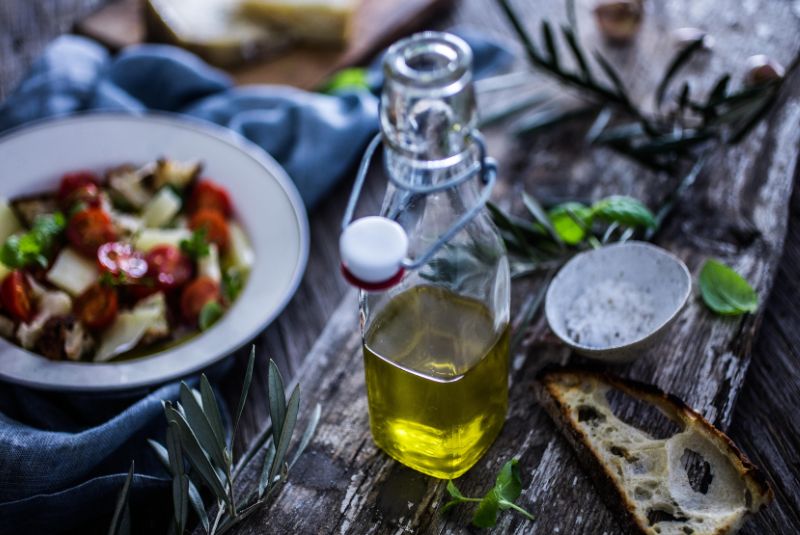
Olive oil is mainly produced in Istria, the Kvarner region and Dalmatia (Image: Maja Danica Pecanic, courtesy of Croatian National Tourist Board)
Some families still hand-harvest their own trees today – a bona fide cottage industry that sees them utilise the local mill to cold-press precious small-batch, extra virgin bottles – just like their ancestors. Even the larger producers are small in scale compared to neighbouring countries, yet the presence of olive oil has remained a daily fact of life since it was lauded as some of the world’s finest by Pliny the Elder during Roman times.
Known for its superlative quality, each variety offers idiosyncratic tasting notes – ancient oblica, grassy, sweetly golden buža, bright green, peppery oil from the bjelica olive, unfiltered and viscous leccino. You’ll find it poured and drizzled liberally over anything from grilled fish to wild Istrian asparagus and sheep’s milk accompanied by pršut (prosciutto-like Istrian ham) – and it’s integral to the superlative local pasta, too.
As nature intended
Sitting toward the southern tip of the peninsula is the historic seafront city of Pula, which hosts the region’s primary airport to fly in and out of. Wander its bustling pesheria (fish market) to witness the day’s catch spread out on slabs in a glass-and-iron-clad art nouveau space built in 1903, when the city was the principal port of the Austro-Hungarian Empire. The likes of bream, palamita, glistening anchovies, chubby Lim mussels and spiny rockfish fresh from the Adriatic waters line up as if offering themselves for the taking as they have for centuries, ready to be grilled over open flames, seasoned simply with a fragrant medley of olive oil, salt, chopped garlic and fresh parsley then served with the likes of locally grown Swiss chard, or mišanca (a mix of wild, seasonal greens and herbs) and new potatoes.
Nearby, at the atmospheric family run boutique hotel and fine-dining restaurant San Roccoloriana Ružić heroes the riches of the natural larder, merging vestiges of the old folk diet and prized local ingredients of international regard with modern flair. Overlooking what was once the Fernetich family’s vines, in the estate’s old cellar, the dining room showcases a seasonal tasting menu that sees each dish paired with a particular estate olive oil – the idea is that each will be used differently, highlighting the scope of its range. With much prepared in a traditional wood-fire oven, elevated takes on grilled market fish sit confidently aside the likes of Istrian veal with fragrant fennel and up-to-date iterations of lamb peka (a stew-like dish under a weighty bell lid cooked over glowing embers) while the area’s unmatched white truffle – more on that later – graces everything from scallops and lardo to tagliatelle and a refined salt-baked potato cream with blackfish. A black truffle semifreddo is a noteworthy end to proceedings. And it’s all backed by a stellar wine list of over 250 regional bins.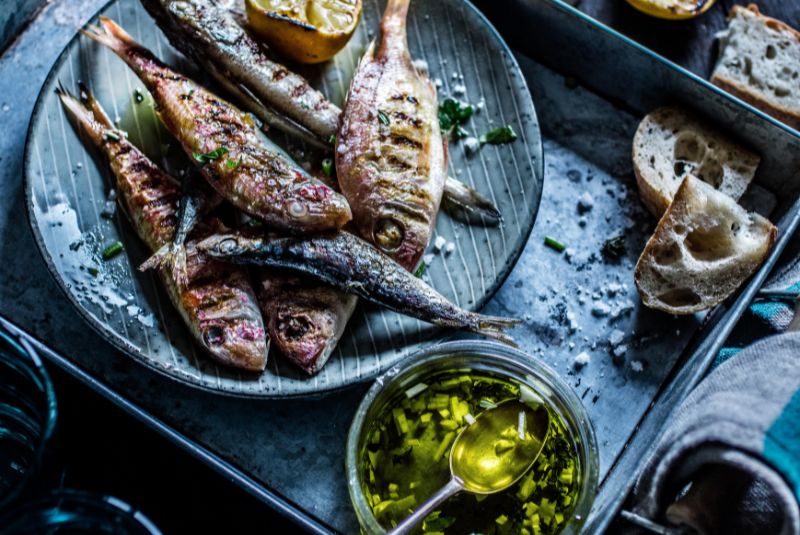
Fresh-caught fish grilled to perfection is a must-eat in Croatia (Image: Maja Danica Pecanic, courtesy of Croatian National Tourist Board)
Travelling north along the coast, passing fortressed towns and dense green clutches, brings you to the romantic honey-toned seafront town of Rovinj. Bobbing on the water, iconic batana fishing boats mark your arrival, an ancient symbol of pride intrinsic to the area’s culture. But Rovinj has been modernising. The arrival of the architectural marvel that is Hotel Lone – the perfect design digs for an overnighter – indicated as much. Then there’s restaurant Monte. Standing out as the flagship for contemporary Istrian cuisine amid the old-school tavernas that dot the town walls, the terroir-first fare of pioneering chef Danijel Đekić afforded it the country’s first Michelin star back in 2017.
A master of Croatian haute cuisine, Đekić’s menu revolves around a locavorian mantra, with ingredients sourced from Rovinj’s farmer’s market and small neighbouring farms, offering three six-course tasting menus inspired by familial memories. At the foot of the Church of St Euphemia, in the stonewall courtyard of his childhood home – and the family’s working taverna from 1985 – Đekić’s creative, dishes celebrate Istrian foodways, pulling out every nuance of flavour from of each ingredient. It’s a veritable ode to Rovinj, with the chef’s deft eye for detail gracing every plate. Examples? Perhaps a trio of Adriatic fish; specialty Lim Fjord oyster with cucumber and lemon jelly; wild boar terrine with wine-poached pears, lentils and fragrant honey and thyme; amberjack with algae tagliatelle, anchovies and black yuzu; Istria’s boskarin beef rib with black trumpet mushrooms; and spinach strudel with goat cheese, pumpkin and edible flowers – a play on Dalmatian soparnik. Sommelier Tjitske Đekić-Brusse treats her wine list with similar reverence to local colour, pouring only great-value and delicious Croatian picks, while the alfresco setting or chef’s table ‘cave lab’ only adds to the sense of place.
It’s a familiar narrative on the terrace at Agli Amici Rovinj, on the edge of the marina. Overlooking the island of St Catherine and the old town, here, chef Emanuele Scarello has crafted two sophisticated degustation menus honing in on Rovinj and Godia (just north of Istria, in Italy, Scarello’s motherland). Capitalising on the generosity of land and sea, and rooted in sustainable practices, dishes capture the scent, flavour and culture of each destination. As you’d expect Adriatic inflections are a given – think turbot with almond milk, lemon and capers from Istria or nearby Kvarner, tender turnip greens and sea lettuce with hazelnut bagna cauda and saffron-laced cuttlefish. Set in the Grand Park Hotel, a luxury bed for the night is within stumbling distance after you’ve had your fill.
On the hunt
Changing pace, and tracing the artery northeast into Istria’s thicketed inner sanctum, the briny sea air is overtaken by the intoxicating scent of lavender, wild sage and bay drifting in on a warm breeze. Passing by roadside stalls touting fresh produce – from honey, fig jams and cheese to medica (honey brandy) – as the coastline fades to the background, it’s clear this far from the end of your culinary adventure. One of Istria’s most significant food heroes lies hidden in plain sight amid the earthy underworld of the Motovun Forest. You’re in truffle country now.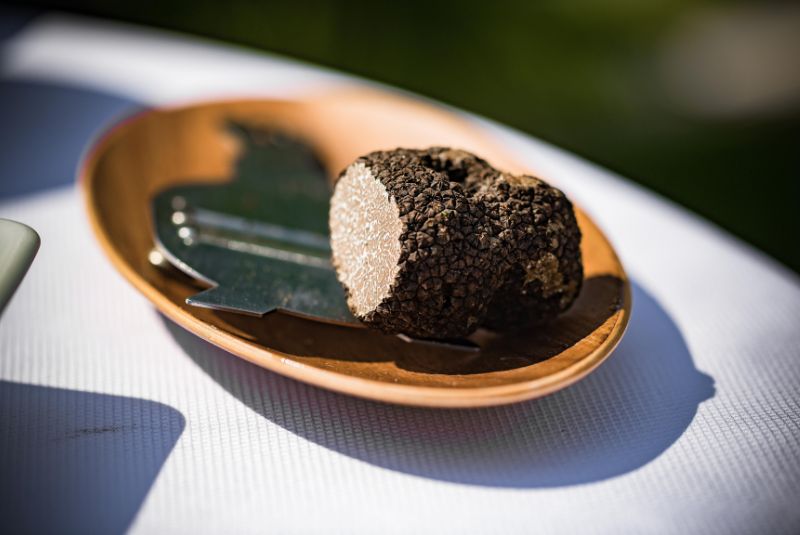
White truffle can only be found between September and January, while Black truffles are found throughout the year (Image: Ivo Biocina, courtesy of Croatian National Tourist Board)
Spreading along the Mirna River Valley, the belt of woodland between the hilltop towns of Motovun and Buzet has been the natural powerhouse behind Croatian menus for decades. Its yield of deliciously pungent fungi can be seen shaved over fritaja (frittata) and fuži and pljukanci pastas, lacing local cheese (ovčji sir s tartufima) and even used in desserts. Snuffled out by expert hunting dogs amid the roots of oaks, pines, poplars and cedars, the exquisite white truffle – tuber magnatum pico – is the ultimate bounty, with prized hauls sent to market to be snapped up by Croatia’s top chefs. Emerging from September to January, it’s excellent quality rivals those found across its Italian and French counterparts. Kept under the radar since it was first mentioned in the annals of the 1940s, the reputation of Istrian truffles was catapulted to the fore in 1999, when Giancarlo Zigante unearthed a record-breaking 1.3kg white truffle. Rather than selling it for a handsome gain, he prepared a blow-out meal so that the locals could enjoy it for themselves. This global luxury is a food for the people in these parts.
But that’s not all you’ll discover here. Alongside October truffle days – a celebration with competitions and cookery classes hosted in Livade, one of the most prevalent truffle towns – truffle-hunting tours (easily organised through local hunters and hotels like the cool, immersive Motovun Roxanich) also help break ground on the black truffle, wild fox mushrooms (chanterelles) and Istrian martinčica. The former is a year-round delight that ensures its place at the table – all you have to do is follow your nose.
A taste of the Riviera
The dramatic landscape of the unsung Učka National Park unites eastern Istria and neighbouring Kvarner, straddling the two in an undulation of forest-clad massifs and abundant native flora. Keep moving southeast, and you’ll emerge, slack-jawed, on the Opatija Rivera overlooking Kvarner’s knockout bay, its horizon daubed with the verdant masses of islands like Krk, Cres and Lošinj. It’s a place shrouded in mythology, which Slavic folk tales say was chosen by the gods who resided on Mount Učka. It was certainly chosen by Austro-Hungarian royalty as the summer resort du jour in the late 1800s, following the construction of the first hotel – Villa Angiolina – by a wheat merchant in 1844. Today, pretty gardens, elegant villas and parks frame its smart promenade.
Think ‘riviera’ and a sense of style over substance often comes to mind. But that’s not the case along this radiant 30km-long curve. While it may have witnessed a litany of visitors from artists and scientists to royals and politicians, the riviera is entrenched in authentic food culture. Branching west along the coast is Konoba Zijavica, a taverna saluting the sand in a small fishing village rich with the patina of a bygone era. The pared-back wood-dressed interior lets the food sing as a team of young chefs led by Stiven Vunić roll out fresh-off-the-boat scampi, pink, plump and straight from the bay (it’s the country’s best) flavoured with tarragon and tomatoes, and tuna carpaccio, before shining a spotlight on hearty octopus stew and marinated red mullet. Vunić’s flavourful craft is an act of pure and simple reverence to what the region provides. Set to the backdrop of crashing waves, it’s a food experience innately connected to the sea.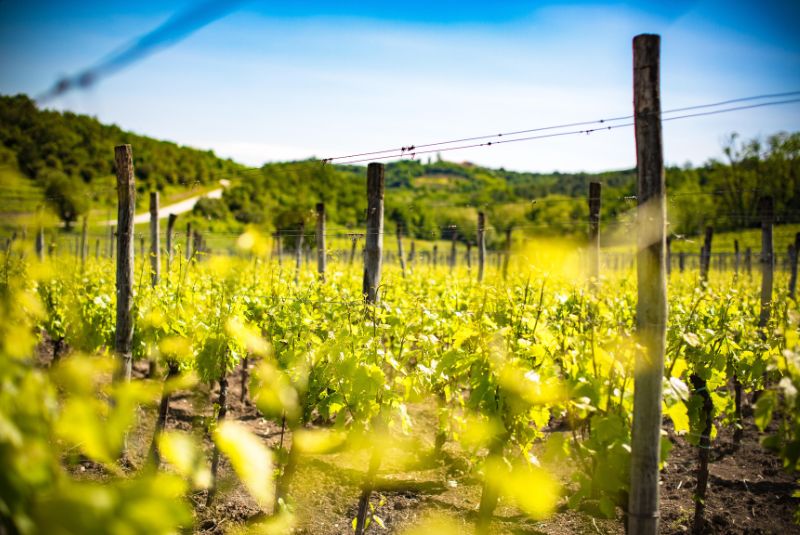
67% of the wine produced in Croatia is white and produced in the interior, while 32% is red and produced mainly along the coast (Image: Ivo Biocina, courtesy of Croatian National Tourist Board)
Back along the coast, Luka Goleš, does an equally fine line in scampi at hotel restaurant Draga di Lovrana, treating them with a classically French fine dining approach. They’re caught from the hotel’s own fishing boat, like much of the seafood that graces the plate. But that’s not all on offer, perched over the bay on the edge of Učka National Park, the menu also aptly navigates that from the land – Kvarner lamb, beloved for its tenderness, blushing deer with foraged mushrooms and pomegranate, and pork belly with Roman gnocchi. Late autumn sees Lovran’s chestnut season in full swing, earning it a spot across Goleš’ dessert list. Along with its dainty pitch-perfect plates, this is a place as much lauded for its sweeping terrace views over to the reefs and Absyrthian Islands beyond, as it is its weighty offering of Croatian wines and inviting bedrooms, making it the ideal place to linger longer.
Island flair
Sojourning island-bound means heading to Rijeka, at the eastern edge of the Riviera, from where the daily passenger boat sets sail. It’s a welcome waypoint for any gastronome – the town’s heritage as a maritime hub has seen centuries of dabbling in national and far-flung ingredients. Along the way, Nebo is an essential pitstop. Crowning the Hilton Rijeka Costabella Beach Resort, it’s a scene-stealing pick that takes Croatian gastronomy to equally lofty heights. Driven to cook by his grandmother’s culinary affinity, Deni Srdoč is one of the country’s highest rated – and youngest – chefs, with a style that sees inventive plays on traditional Croatian cooking underpinned by modern technique and a zero-waste ethos across a multi-course menu. Hyper-artistic dishes – say mussels crème brûlée; black pig cheeks with celery and Jerusalem artichoke; garlicky local snails sitting on a bed of millet or red gurnard paired with wild asparagus and nasturtium – complement the fresh, modern space to a tee.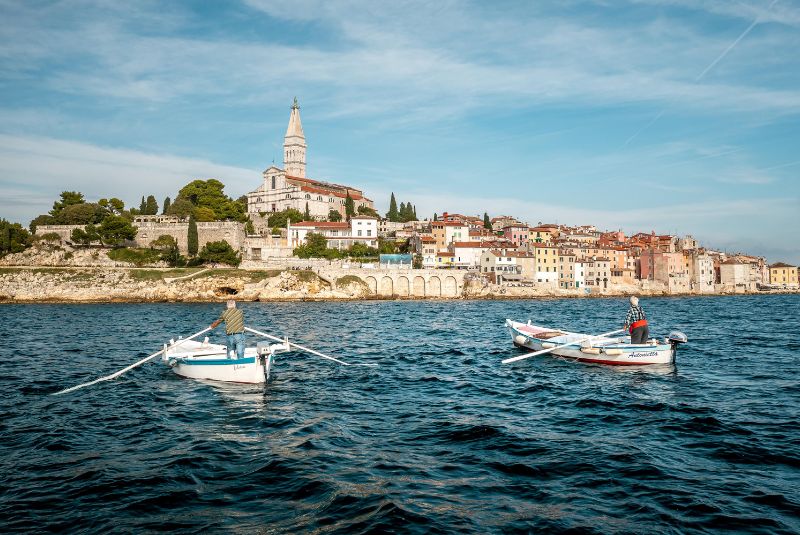
The Adriatic Sea contains more than 1,200 islands, mostly located along the Croatian part of its eastern coast (Image: Julien Duval, courtesy of Croatian National Tourist Board)
While there are endless reasons to visit Lošinj, with its unique wildlife, sunbathed towns and bora-bleached cliffs backed by heavily scented umbrella pine and myrtle shrubs, a highlight is to experience the relaxed-yet-refined confines and superb food emerging from the kitchens at Alfred Keller, in the art nouveau-leaning Boutique Hotel Alhambra. Floor-to-ceiling windows wrap curvaceously around panoramas of the stunning, sandy Čikat Bay and framing greenery, providing an evocative backdrop to any meal. The man behind it is Michael Gollenz, who prepares sustainably sourced local ingredients – from Lošinj and the immediate surrounds – with French technique while elevating flavours with globetrotting nous. Try his scampi tartare with Thai salsa and mint and you’ll get the idea. For Gollenz, respect for tradition is key, but it should never compromise innovation – and it’s an ethos that’s fared him well. Over three or four courses, you might come across the likes of pan-roasted Adriatic fish with fennel kulen, skuta (a local cheese) with raspberry, basil and lemon or barbecued short rib with paprika – a taste of Austrian-Hungarian heritage that lingers to the modern day. The wine list equally nods to history, with progressive pours from Croatia and the Balkans present and accounted for.
A toast to the region
Teran. Žlahtina. Refošk. These grapes may sound unfamiliar to even those most familiar with European wine, but you’ll soon get know them on a trip here. With as much nuance and variety as its food scene, Croatia’s wine culture demands the raising of a glass. Vineyards dot the landscape across the northern Littoral regions of Istria and Kvarner. The coastal route from Poreč to Novigrad, Rovinj and Pula, is flanked by vines; in Buje there’s a winemaker on every corner. And some of the best vineyards are found in Buzet and Pazin. Meanwhile, the island of Krk is home to the Vrbnik Žlahtina – a grape which grows here and here alone. Viniculture here is a tale of native grapes, a special climate, boutique wineries and, more importantly, the creation of a unique cellar.
While the big-player grapes are on hand, it’s the lesser-known varieties that are the most exciting. Across coastal Istria – one of the country’s main wine regions – terracotta-rich irony soil brings the riches of late-harvest Borgonja and Teran, a wine that once fortified Casanova. Often called black wine for its sultry hue, the latter is light in tannin with robust ripe cherry on the palate. There’s also the gilded glory of the widely grown Malvasia (introduced by the Venetians), a refreshing pour and the perfect foil for seafood. Places like Umag and Poreč, have nurtured the winemaking tradition for hundreds of years and have mastered the art of ensuring the perfect balance of stone fruit, citrus and salinity. Then there’s aromatic Muscat, suited best to growing inland as the terra rossa eases to limestone-laced white and grey soil. Momjan comes with the perfect terroir for crafting it as a luscious dessert wine. At that’s not to mention progressive winemakers’ effervescent riffs on champagne and underwater aging. A number of famous wine roads – at their peak during the autumn harvest – will take you right to the cellar doors.
While Kvarner may produce the smallest volume of Croatia’s wine, what it lacks in quantity, it makes up for it quality. The first vines came from the Greeks, thought to be in the sixth century. The bay area has smaller sub regions producing less-familiar varieties – Sansigot, Refošk, Trojišćina, but Krk produces the most highly regarded variety, from ponca soil laden with ancient sandstone. Grown exclusively on vines set on a sheltered valley in the shadow of the hilltop town of Vrbnik, Žlahtina is a delicately sophisticated pale-yellow wine with fresh, vivid flavour and a gentle bouquet. It’s name comes from the Slavic for noble. Enjoy it with a board of salty Grobnik and nutty Pag cheese and you’ll see why.
Perhaps most interesting, is the fact that much of the wine produced in Croatia, stays on Croatian soil, with restaurants keen to buy it up as they believe it to be a key trope in their national culinary tale. Indeed, back on the riviera, Plavi Podrum’s sommelier, Daniela Kramaric, has crafted one of the best lists in the country, twice winning the title Best Sommelier in Croatia along the way. Stop by and see it for yourself, and end your adventure on a sweet note with a portion of Rapska torta (Rab island cake) – a spiral of almond-laced loveliness drenched in homemade maraschino liqueur. Because if there’s one thing a gourmet adventure across Croatia teaches you, there’s always some local delicacy nearby that’s not to be missed.
Continue your journey around Croatia’s delicious food and drink on croatia.hr.